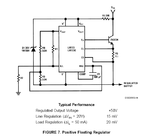jigshaw
Member level 1
Has anyone appicated LM723 with floating positive regulator?
This circuit was a typical floating positive regulator from datasheet of LM723_NS.

I use this circuit in my design to get a linear 48V regulator with 83V unregulated DC input.
But it does not work at all.
The Vref pin output with an unstable voltage about 74V to ground and the output always gives unstable output range from 80 to 82V.
When with load (approximately 1A) connected,the output drops to 0V immediately.
The ouput will increase to 80 V slowly after load moved away.
The only difference in my circuit is I using 1N5365B(5W,36V) zender instead of 1N1364(10W,36V).
Can anyone give me some suggestions?
Thanks.
This circuit was a typical floating positive regulator from datasheet of LM723_NS.

I use this circuit in my design to get a linear 48V regulator with 83V unregulated DC input.
But it does not work at all.
The Vref pin output with an unstable voltage about 74V to ground and the output always gives unstable output range from 80 to 82V.
When with load (approximately 1A) connected,the output drops to 0V immediately.
The ouput will increase to 80 V slowly after load moved away.
The only difference in my circuit is I using 1N5365B(5W,36V) zender instead of 1N1364(10W,36V).
Can anyone give me some suggestions?
Thanks.

